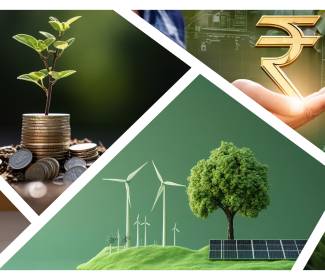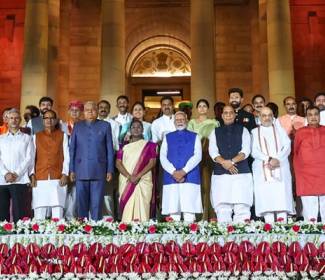In October 2018, Prime Minister Narendra Modi proposed the idea of One Sun, One World, One Grid (OSOWOG) for the first time at the First Assembly of the International Solar Alliance (ISA). During COP26 in November 2021, the Green Grids Initiative (GGI) was launched by the United Kingdom (UK) as a key enabler of net zero in India’s and the UK’s shared vision of 2030. The two countries aim to establish a collaborative framework for global cooperation in maximising the utilisation of renewable resources, ensuring that clean and efficient energy becomes a dependable alternative for meeting the energy needs of all nations by 2030.
GGI and the OSOWOG initiative were unveiled jointly by India and the UK as part of their bilateral collaboration in conjunction with the International Solar Alliance (ISA) and the World Bank Group (WB). These initiatives, focusing on the global transition to renewable energy, were subsequently merged into a unified effort named GGI-OSOWOG, emphasising a collective commitment to a common goal. This first-ever international network of interconnected solar grids seeks to connect 140 countries to continuous solar power and has been endorsed by 80 ISA Member Countries.
The vision behind the OSOWOG initiative is the mantra that “the sun never sets”. The idea is to harness solar energy from different parts of the world, where the sun is shining at any given moment, and efficiently transmit that power to areas where it is needed. By creating a connected global grid, regions that experience daylight can contribute excess solar power to other regions that may be in darkness, balancing energy production and consumption on a global scale.
Making an Impact through Global Interconnections
The OSOWOG initiative is to be carried out in 3 phases:
In the first phase, the Indian grid would be connected to the grids of the Middle East, South Asia and South-East Asia to develop a common grid. This grid would then be used to share solar energy as needed, in addition to other renewable energy sources.
The second phase would connect the functional first phase to the pool of renewable resources in Africa.
The third phase would look at achieving true global interconnection with the aim of 2,600 GW of interconnection by 2050. The goal is to integrate as many countries as possible to create a single power grid of renewable energy. This can then be accessed by all countries.
Given the geographical focus of the OSOWOG plan, it is evident that the ISA serves as an initial stride for India to assert its influence in the global conversation on solar energy. While addressing a conference on Transnational Grid Interconnections for One Sun, One World, One Grid in September 2023, Union Minister for Power and New & Renewable Energy, Shri R. K. Singh, informed that India already has interconnection of grids with Nepal, Bangladesh, and Myanmar, while negotiations are on with Sri Lanka, Singapore, UAE, and Saudi Arabia. He said that an international group of countries has been constituted, which is looking at a draft agreement to implement the OSOWOG initiative. ISA also aims to mobilise $1 trillion of funding by 2030 to assist developing countries in expanding their solar power grids to meet their energy needs.
The OSOWOG initiative will help in three energy transitions:
- Switch of energy production from fossil fuel to clean energy
- Switch of energy allocation from local balance to cross-border and global distribution
- Switch of energy consumption from coal, oil and gas to electric-centric consumption
What makes OSOWOG essential in the current global landscape is the increased focus on climate change and move towards sustainable development. It has become clear with the COVID-19 pandemic that everyone is interconnected and each individual and nation has a responsibility towards the other. When climate change affects everyone around the globe, perhaps, the reverse that ISA proposes with an interconnected, global energy grid would be the positive step to tackle it.
India’s role at OSOWOG
India’s goal to achieve 500 GW non-fossil-based electricity generation capacity by 2030 aligns with its efforts to be Net Zero by 2070. The nation has been transformed from power-deficient to power-sufficient. In 2023-24, out of total generation capacity of 9,943 MW added, 8,269 is from non-fossil fuel sources. As per Renewable Energy Statistics 2023 released by the International Renewable Energy Agency (IRENA), India has the 4th largest installed capacity of renewable energy.
It is imperative for India to not only find alternatives to coal-based fuels but also secure its energy demands in sustainable manner. GGI-OSOWOG is the ambitious plan to attain this goal. India urgently needs to shift to solar power due to three impending issues. Firstly, India is likely to account for 25% of global energy demand growth over the next two decade, necessitating a move towards solar for enhanced energy security and self-sufficiency while mitigating environmental impacts. Failure to do so may increase dependence on coal and oil, leading to economic and environmental costs. Secondly, rampant air pollution emphasizes the need for cleaner energy sources like solar to combat pollution caused by fossil fuels. Lastly, declining groundwater levels and decreasing annual rainfall underscore the importance of diversifying energy sources. Solar power, unlike coal, doesn't strain groundwater supplies. The extensive use of solar power plants is a crucial step towards cleaner, cheaper, and sustainable energy, offering benefits at both utility and individual levels.
Implementing OSOWOG would solidify India's standing as a global leader within the International Solar Alliance and stimulate economic growth. India's venture into establishing an "inter-continental power infrastructure" is a novel concept, holding potential geopolitical advantages for the country. Despite the affordability of battery and storage technology, challenges such as a shortage of land and limited daily sunlight hours persist globally. Consequently, obtaining solar energy from other nations emerges as a more practical and innovative solution.
Challenges and Way Forward
Building consensus among 140 nations and addressing geopolitical challenges, logistical issues related to land availability, potential problems arising from weather changes, wire breakage, securing finances, etc., makes the realisation of this ambitious project all the more difficult.
Achieving energy access within the available short timeframe requires targeted interventions addressing key factors. These factors include:
- Establish supportive policy frameworks for organised progress
- Secure affordable long-term finance and use innovative financial instruments, crucial for projects in heavily affected regions and attracting private sector investments
- Implement capacity building and training in access-deficit countries, focusing on affected areas
- Create an enabling environment through updated data access and quality standards for mini-grids and distributed renewable energy
The move towards One Sun, One World, and One Grid signifies a pivotal future for renewable energy systems. This project play a crucial role in fostering international collaboration, enabling the balanced and shared use of renewable energy sources globally.
Successfully completing this project not only reinforces India's leadership in the International Solar Alliance (ISA) but also provides substantial support to the Indian economy. The broader impact includes promoting global sustainability and enhancing societal resilience against climate change.
- https://isolaralliance.org/uploads/docs/52e970d74272c9079053d966043b80.pdf
- https://pib.gov.in/PressReleaseIframePage.aspx?PRID=1955243
- https://www.hindustantimes.com/india-news/one-sun-one-world-one-grid-pm-modi-calls-for-global-solar-grid-at-cop26-101635877791812.html
- https://pib.gov.in/PressReleaseIframePage.aspx?PRID=1992405
- https://pib.gov.in/PressReleasePage.aspx?PRID=1992732
- https://pib.gov.in/PressReleaseIframePage.aspx?PRID=1966227#:~:text=He%20said%20that%20at%20present,next%20two%20decades%2C%20he%20emphasised.
- https://isolaralliance.org/uploads/docs/540dc1da191598c88320bf07b42e8d.pdf






